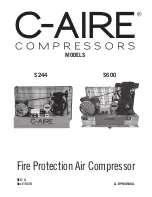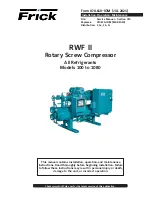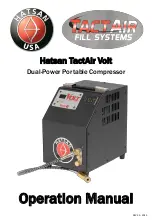
070.655-IOM (FEB 22)
Page 21
SBTP Rotary Screw Compressor
Maintenance
Maintenance
General information
This section provides instructions for normal maintenance,
a recommended maintenance program, and troubleshoot-
ing and correction guides.
WARNING
This section must be read and understood before
attempting to perform any maintenance or service to
the unit.
CAUTION
Cylinder assembly under high spring load. Consult
manual before disassembly. Incorrect disassembly
may cause injury due to spring tension release.
Normal maintenance operations
When performing maintenance you must take several
precautions to ensure your safety:
1. If unit is running, press the
STOP
key.
2. Stop the motor and lock out the starter before per-
forming any maintenance.
3. Wear appropriate safety equipment when the compres-
sor unit is opened to atmosphere.
4. Ensure adequate ventilation.
5. Take necessary safety precautions required for the gas
being used.
General maintenance
Correctly maintaining the unit is important in ensuring long
and trouble-free service from your screw compressor. Some
areas critical to good compressor operation are:
• Keep oil clean and dry, avoid moisture contamination:
after servicing any portion of the refrigeration system,
evacuate to remove moisture before returning to ser-
vice. Water vapor condensing in the compressor while
running, or more likely while shutting down, can cause
rusting of critical components and facilitate the forma-
tion of acids, thereby reducing the life of the unit.
• Keep suction strainer clean:
check periodically, particu-
larly on new systems where welding slag or pipe scale
could find its way to the compressor suction. Excessive
dirt in the suction strainer could cause it to collapse,
dumping particles into the compressor.
• Keep
oil filters clean:
if filters show increasing pressure
drop, indicating dirt or water, stop the compressor and
change filters. Running a compressor for long periods
with high filter pressure drop can starve the compressor
of oil and lead to premature bearing failure. Dual oil fil
-
ters are recommended so that the filters can be changed
without shutting down the package.
• Avoid slugging the compressor with liquids (oil):
while
screw compressors are probably the most tolerant of any
compressor type available today about ingestion of some
liquid, they are not liquid pumps. Make certain a correct-
ly-sized suction accumulator is used to avoid dumping
liquid into compressor suction. Ensure the economizer
line has an accumulator, and that all refrigerant and oil
lines drain away from the compressor.
• Protect the compressor during long periods of shut-
down:
if the compressor is going to be sitting for long
periods without running, it is advisable to evacuate to
low pressure and charge with dry nitrogen or oil. This
is particularly true on systems known to contain water
vapor.
• Preventive maintenance inspection:
this is recom-
mended any time a compressor exhibits a noticeable
change in vibration level, noise, or performance.
Changing the oil
WARNING
Do not mix oils of different brands, manufacturers, or
types. Mixing of oils may cause excessive oil foam-
ing, nuisance oil level cutouts, oil pressure loss, gas
or oil leakage and catastrophic compressor failure.
To change the oil, perform the following steps:
1. Stop the compressor unit.
2. Lock out the motor starter.
3. Close the suction and discharge service valves.
4. Using appropriate equipment, lower the compressor
pressure to 0 psig.
5. Open the drain valves and drain oil into a suitable
container.
6.
Drain the oil filters and the oil coolers.
7.
Remove the old filter cartridges, and install new ones.
8. Remove, clean, and reinstall elements in the strainers.
9. Evacuate the unit.
10. Open the suction service valve and pressurize the unit
to system suction pressure. Close the suction valve and
leak test.
11. Add oil.
12. Open the suction and discharge service valves.
13. Remove the lockout from the motor starter.
14. Start the unit.
Maintenance program
In order to obtain maximum compressor performance and
ensure reliable operation, follow a regular maintenance
program:
• Check the compressor unit regularly for leaks, abnor-
mal vibration, noise, and that it is operating correctly.
• Maintain a log.
• Perform an oil analysis on a regular basis. It is a valu-
able tool that can identify the presence of moisture,
acid, metallics, and other contaminants that can
shorten compressor life if not corrected.














































